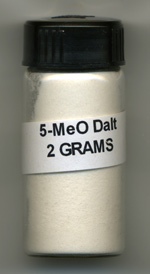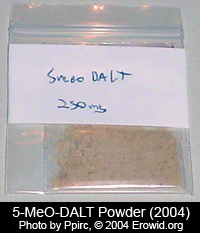What Drug Is in My Drug?
Chemical Analysis of 5-MeO-DALT and Discussion of Inconsistent RCs in the 2010 Market
v1.0 - Nov 4, 2010
Citation: Erowid E, Spoon. "What Drug Is in my Drug? Chemical Analysis of 5-MeO-DALT and Discussion of Inconsistent RCs in the 2010 Market". Erowid.org. Nov 4, 2010.
"Chemistry is pornography in disguise, you just have to know which functional group to look at." -- Alexander Shulgin5-MeO-DALT is a psychoactive chemical first reported publicly by Alexander Shulgin in May 2004, via a pre-publication draft of an entry from a forthcoming book. It was synthesized and distributed by online chemical vendors soon after. Shulgin reported the dosage as "12-20 mg. orally" and the duration as two to four hours.
Reports of use trickled in, with the usual range of descriptions of effects--from positive to nonplussed to disappointed. But in 2010, a handful of forum posts to BlueLight.ru suggested that there might be "different batches" floating around and being sold by different vendors.1 Some reports indicated radically higher doses than Shulgin had described while others described powders that seemed like they might be inactive.
We decided to look into this to issue to see if we could help answer the question of what the difference was between some of these materials.
In September 2010, Erowid analyzed two samples of 5-MeO-DALT, both initially sold through online vendors. One sample was acquired from an online vendor by an Erowid volunteer who submitted it to Erowid for analysis, while the other came from a randomly selected company advertising 5-MeO-DALT via Google. The sample submitted by the volunteer was very pure 5-MeO-DALT. However the sample purchased online contained no 5-MeO-DALT. The laboratory that did the testing could not identify the chemical with 100% certainty, but expert chemists agreed it was clearly a cathinone derivative and could be 4-fluoromethcathinone (flephedrone).

We have published the results (including GC/MS output) on EcstasyData as ID: 2025 and ID: 2026.

|
After the popularity and subsequent legal control of some cathinone derivatives in the UK, Ireland, and parts of northern Europe in 2009 and 2010, it seems as if stockpiles of the newly illegal products existed and were then resold as other chemicals by unscrupulous or misinformed vendors. For instance, after 4-methylmethcathinone (mephedrone) was controlled in the UK in April 2010, and according to analysis of products before and after the effective date of the law, it was still appearing in some products without being identified as mephedrone to customers.3
Interestingly, this is a new type of legal risk for consumers of research chemicals: controlled substances being sold as legal (grey-market) products. Purchasers can unwittingly receive an illegal drug when they thought they were purchasing a substance that was explicitly legal in their jurisdiction.
We hope that analysis of research chemical products available on the open market will continue to expand, and that the DEA will eventually lift its ill-conceived restrictions on the ability of U.S. laboratories to analyze controlled substances for Erowid and U.S.-based harm reduction organizations.
References #
- skunkjar. "The Big & Dandy 5-MeO-DALT Thread". Bluelight.ru. May 4, 2010. http://www.bluelight.ru/vb/showpost.php?p=8348078&postcount=238. Accessed Sep 2010.
- Brandt SD, Sumnall HR, Measham F, Cole J. "Analyses of Second Generation 'Legal Highs' in the UK: The Confusing Case of NRG-1". BMJ. Jul 16, 2010.
- Ramsey J, Dargan PI, Smyllie M, et al. "Buying 'Legal' Recreational Drugs Does Not Mean That You are Not Breaking the Law". QJM. Jul 2, 2010.
- Davies S, Wood DM, Smith G, et al. "Purchasing 'Legal Highs' on the Internet--Is There Consistency in What You Get?". QJM. Jul 2010;103(7):489-493.



